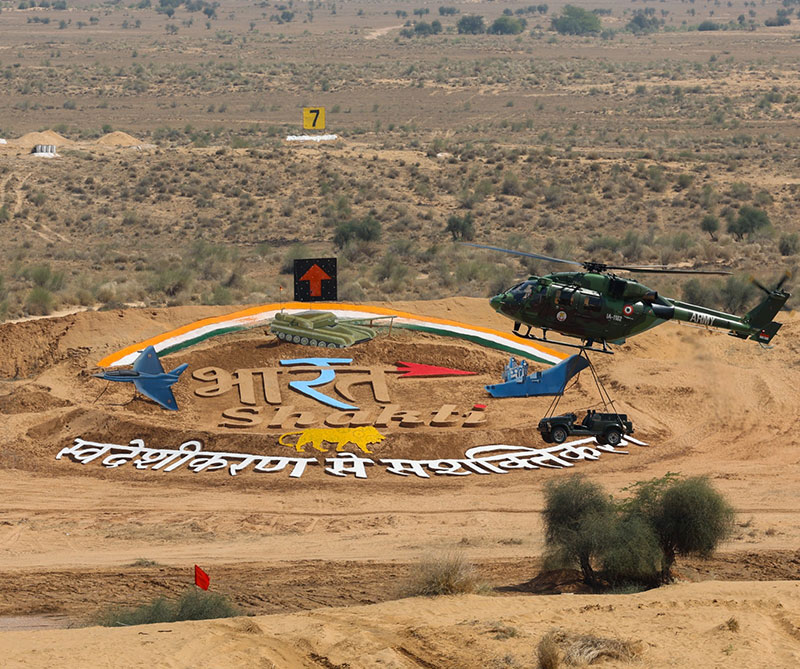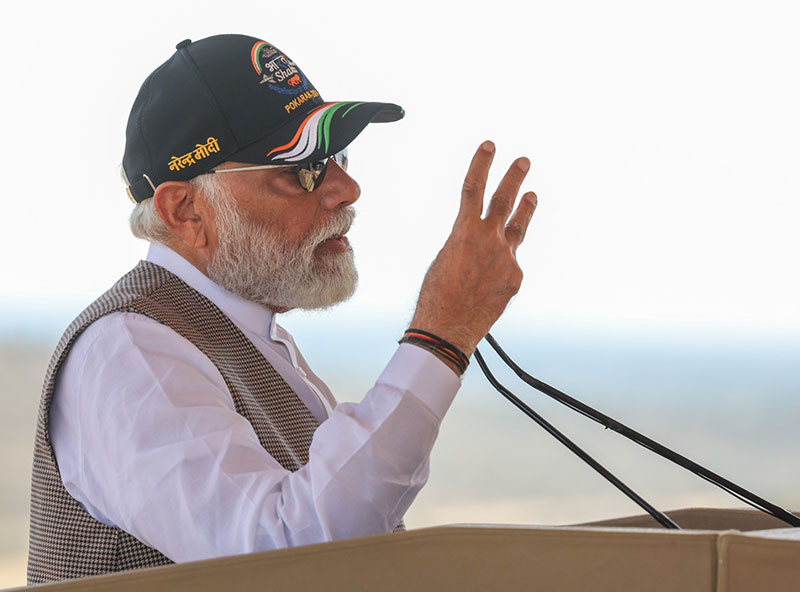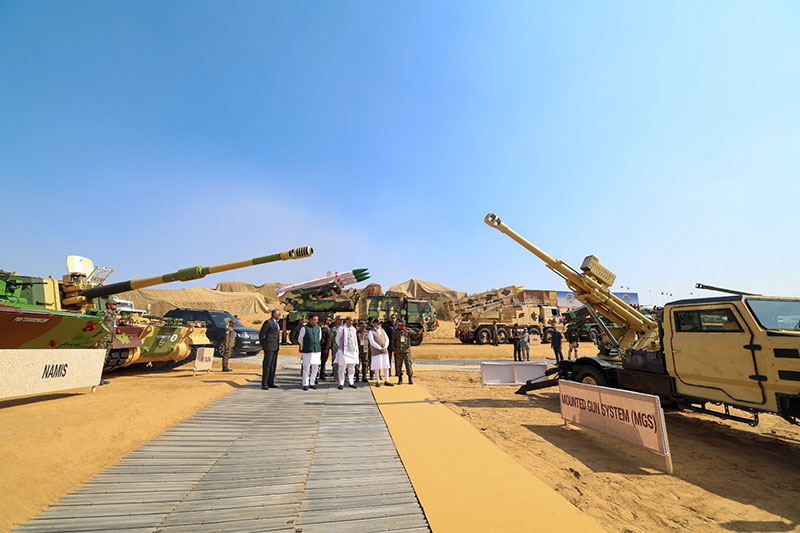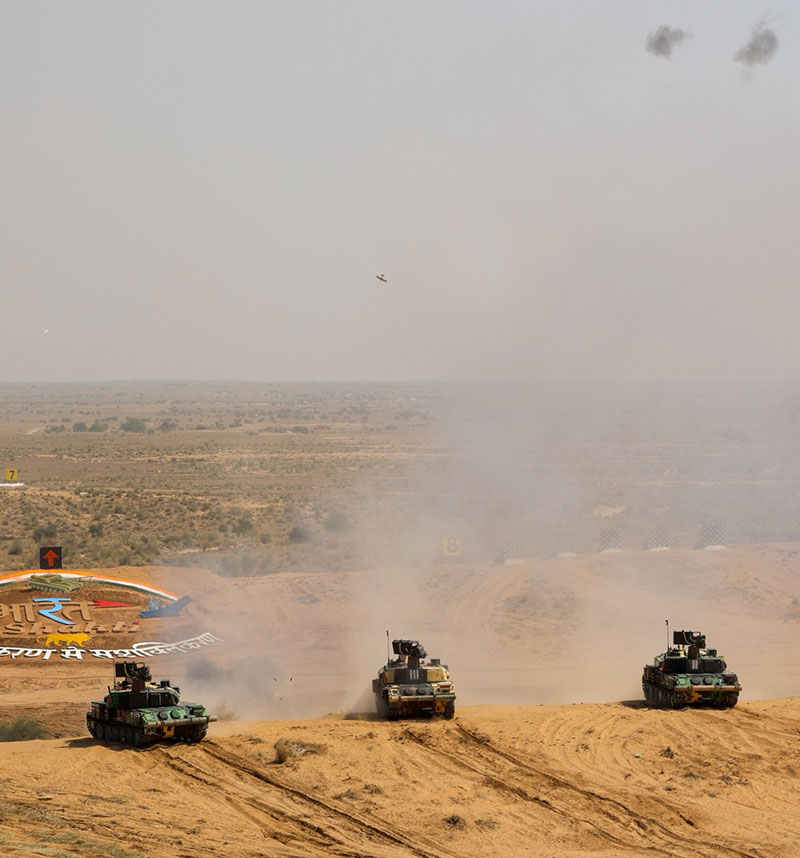Exercise Bharat Shakti exposes Indian Army’s claims of preparedness
Pravin Sawhney
A month after the Indian Air Force conducted its Exercise Vayu Shakti in the desert of Pokharan with elements of the Indian Army to demonstrate ‘jointness’, the latter returned the favour in full measure. The Indian Army conducted Exercise Bharat Shakti in Pokharan. Going one-up on the IAF, it told the media that its exercise was a tri service endeavour. While some elements of the IAF were visible in the sky over Pokharan, the Indian Navy was apparently also conducting some manoeuvres in the sea coinciding with the land exercise, which showcased simulated ground-based firing, obstacle fording and tank manoeuvres.

The star attraction was the Bharat Shakti artistic installation in sand showcasing models of a tank, a fighter and an aircraft carrier with ‘Swadeshikaran se Sashastikaran’ (empowerment through indigenisation) emblazoned across it. That this was the star of the exercise was evident from the fact that most of the action took place around or over it, so that it remained in all photo frames. Even Prime Minister Narendra Modi who took stock of India’s military preparedness by witnessing Bharat Shakti, which translates into India’s power, posed extensively with the installation which effectively encapsulated his slogan of ‘Aatmanirbhar Bharat’. A remarkable coincidence two months before the General Elections.
Interestingly, the official press release claimed that ‘Bharat Shakti will simulate realistic, synergised, multi-domain operations displaying integrated operational capabilities of the Indian Armed Forces to counter threats across land, air, sea, cyber, and space domains.’
Notwithstanding the gaps between the claims, the demonstration, and the exercise, it was evident that India continues to prepare for a hugely outdated war. This is deeply worrying, especially when India’s primary threat, the PLA, is at the cutting edge of modern warfare in technology, war concepts, capabilities, and capacities. Worse, there is a standoff at the Line of Actual Control for four years.
Before analysing the Indian military narrative, a good start would be to use the Pentagon prism to know PLA’s modern war capabilities, which Indian is also up against. By 2010, the Pentagon was aware that China had operational systems (software networks which connect all war domains) and guided munitions that were as capable as its own. It could close the kill chain as quickly as the US military. The PLA could do stand-off precision attacks at long ranges as good as the US military with its indigenous mortars, rockets, missiles, and artillery projectiles most of which were guided. Coupled with increasing miniaturization, guided weapons brought unprecedented lethality at long ranges. Once this realisation came, there were brainstorming sessions in the Pentagon on how to offset PLA’s combat advantage. Finally, in 2014, the Pentagon announced its third offset strategy by which the PLA advantage was sought to be outmatched by use of Artificial Intelligence (AI) and autonomy by the US military.
Meanwhile, China in 2015 did two things: it announced its ‘Made in China’ programme to focus on key emerging technologies including AI, and the PLA declared its major structural reforms. Both programmes created challenges for the US military which had concluded that PLA was its primary threat, just as India did in 2020.
The PLA’s military reforms created a new organisation called Strategic Support Force (SSF), and Xi Jinping as the Chairman of the Central Military Commission announced timelines to accomplish military modernisation in three stages called mechanisation (building of required platforms for physical land, air, sea war domains), informatisation (for integration and synergy in multi-domain operations), and intelligentisation (use of AI and other emerging technologies in informatised war). The PLA declared that it could combat in four physical (land, air, sea, outer space) and two virtual (cyber and electromagnetic spectrum) domains.

After analysing PLA reforms, the Pentagon was baffled by two things:
One, the PLA’s use of AI in its software networks. Aware of China’s progress in software systems, the former US deputy defense secretary, Robert O. Work, said in September 2020, ‘Between Russia and China, China is the most dangerous competitor since a major strength for China is the intangible autonomy of software systems and communications networks that comb through vast amounts of sensor data to spot targets, route supplies, schedule maintenance, and offer options to commanders.’
And two, the PLA’s SSF. As Robert Work observed in 2019, ‘The US should consider replicating the Chinese model of a single unified Strategic Support Force overseeing satellites, cyberspace, electronic warfare, and information warfare—functions that the US splits between Space Command, Cyber Command, and other agencies. I think the unified Strategic Support Force is a better way to go, but this is something that would be analysed, war-gamed, experimented with.’
Another development that started shaping the PLA battlefield was increased weapon systems automation; fewer soldiers were required to operate gun systems, air defence systems, and other weapons platforms. The PLA cut its manpower by 5,00,000 in 1997, by 2,00,000 in 2003, and 3,00,000 under Xi’s 2015 military reforms. The PLA manpower cut was also evidence that its war had shifted from land to other war domains. Thus, from attrition, which is hallmark of tactical battles, the PLA war called ‘systems destruction warfare’ was to deny communications to the enemy at all levels of war. This was to be done by SSF, more on this later.
The Indian military, on the other hand, focussed on land war or attrition war and has progressive increased its manpower. Today, the PLA ground forces (or army) are 9,65,000 soldiers against Indian Army’s nearly 13,00,000 troops.
Meanwhile, China’s ‘Made in China’ was followed by its 2017 New Generation AI Development Plan with the goal to become a global AI leader by 2030; this would spur PLA’s intelligentised war. Fully supported by civil-military fusion (the ability of commercial and defence industries to work together seamlessly), the Pentagon was once again at sea to meet the challenge given that in corporate America, the technological companies are uncomfortable working for the Pentagon. To bring the disparate enterprises together the Pentagon created new organisations and positions like JAIC (Joint Artificial intelligence Centre), DIU (Defence Innovation Unit), CDAO (Chief Digital and AI Officer) and so on to support DARPA (Defence Advanced Research Projects Agency) to bridge the divide for easy assimilation of dual-use emerging technologies for US military. Moreover, conscious about China’s extraordinary ability at mechanisation where it indigenously built more tanks, guns, ships, aircraft than the US military, the Pentagon, in August 2024 announced its Replicator programme to offset PLA’s battlefield advantage of more numbers of platforms. Announced by US deputy defence secretary, Kathleen H. Hicks the programme is meant to build thousands of autonomous drones (cheap and scalable) across multiple war domains within 18 to 24 months to counter China’s rapid armed forces build up.

Coming to the SSF, it is a service like the army, air force, and navy with strength of 1,65,000 regular soldiers as of 2022. Headed by a Lt Gen. rank officer, it has under it, two main departments, namely, network system department and space system department, each headed by a deputy Lt Gen. grade officer. The network system department oversees two virtual war domains of cyber and electromagnetic spectrum, as well as information warfare (for spreading disinformation, misinformation, deepfakes, and synthetic reality) in addition to technical reconnaissance capabilities for the two virtual domains. The space system department is responsible for both civilian and military satellites/ space stations and activities related to it. As of 2022, this department operated a fleet of over 300 military satellites with directed energy weapons being tested in space. These satellites are fully supported by Baidu constellation of 45 satellites with military resolutions.
In comparison, Indian defence space agency established in 2019 has 14 military satellites of which only two are specifically for services’ use for communications. The navy’s GSAT-7R communication satellite which was to replace older GSAT-7 (called Rukmini and meant to provide real time link between landing stations, ships, submarines, and aircraft) is delayed by two years. The IAF has GSAT-7A for communications while the dedicated army satellite (GSAT-7B to be built by ISRO has not started yet.
Thus, the SSF covers the domains of cyber, EMS, and space which is really the continuum through which all wired and wireless communications are done in battlefield. The cyber malware (malicious software) attacks the data or information which passes through cyberspace while the electronic fires attack the electromagnetic waves that carry the data or information. Both the cyber and electronic fires are unstoppable since they travel at the speed of light. In operational terms, any nation without relative ability to combat, contest, and confront the PLA in this critical continuum of virtual domains will lose the war in little time since its forces, by denial of communications will be rendered blind and deaf leading to command breakdown.
The SSF has two tasks in war. One, it is a strike force with ability to do ‘systems destruction warfare’ by its strategic information operations to destroy, disrupt, and debilitate enemy’s communication nodes. And two, to be the nervous system to provide real time full picture for joint integrated multi-domain operations to the five theatre commands. This role is called strategic information support role. Lacking even modest ability to take on the SSF, the Indian military will be badly hit by PLA’s non-kinetic war capability.
In addition to the SSF, the PLA, as part of its military reforms, re-named and re-organised its second artillery to be called PLA Rocket Force (PLARF); this is the fifth service of the PLA. The PLARF has all land-based missiles to include ballistic, cruise, and hypersonic cruise and glide vehicles under it. Since the PLA has a lead over the US military in operationalisation of its hypersonic cruise missiles and glide vehicle, as well as testing of Fractional Orbital Bombardment System (FOBS) done in August 2021, there are reports of PLA declaring ‘near space’ (altitude of 20km and above till 100km where outer space begins) as a new war domain. The PLA, thus, has five services (ground forces, air force, navy, SSF, and RF) to combat in six domains of land, air, sea, cyber, electromagnetic spectrum, and outer space with the seventh ‘near space’ domain likely to be raised soon. In comparison, the Indian military has three services and can combat in three domains only.

Under this backdrop, let’s examine the Indian Army’s claims, demonstration, and the reality of Exercise Bharat Shakti. The claim that the exercise ‘simulated realistic, synergised, multi-domain operations displaying integrated operational capabilities of the Indian Armed Forces to counter threats across land, air, sea, cyber, and space domains’ is a lie.
To begin with, Indian military does not have cyber and space war domains. It instead has modest defensive capabilities under its cyber defence agency and space defence agency headed by two-star rank office working under the Integrated Defence Headquarters headed by the Chief of Defence Staff. Since cyber and electronic fires travel at the speed of light, limited defensive capabilities are meaningless. The need is for offensive capabilities with the mantra of attack, attack, and more attack. And offensive countervalue and counterforce software weapons in cyberspace needs nano-capabilities which India lacks; DRDO has listed this as future capability on its wish list. Moreover, PLA is known to use AI in both cyber and electronic fires. Use of AI in cyber will make the attacks more precise, tailored, stealthier and persistent with cyber campaign becoming more effective on a large scale to include whole-of-nation as well as the battlefield. Moreover, PLA has been working on AI in electronic warfare to be called cognitive electronic warfare which will make electronic fires more effective and lethal on the fly in case of combat aircraft and drones.
Now, let’s see what ‘synergised and multi-domain operations’ means before examining the claim. Multi-domain operations mean that any domain capability can be used for targets in a different domain to achieve optimal results. For example, while the IAF will use its sizeable combat power to achieve a reasonable air superiority for successful strike operations against the PLA, the reverse will not be true. The PLA could instead use its rocket force to accomplish air dominance by hitting IAF bases, fuel dumps, ammunition points, and aircraft on ground, while saving PLAAF’s massive inventory and long-range drone units for offensive operations. This is only possible when all domains are networked with the operations centre or command and control centre. With such operations, the PLA will not only achieve operational surprises, but also create synergy between its domains when capability of one domain is strengthened by another domain.
Since Indian military’s three physical domains are not networked, which is the critical requirement for multi-domain operations, it cannot even do tri-service operations, which Bharat Shakti claims to have demonstrated. Regarding the exercise being ‘realistic’ the little said the better. Without exception, all exercises where media and political leaders, let along the Prime Minister is invited, are stage-managed. They are not held in electronic warfare contested environments, where each side is presented with tactical surprises.
The reality is that both Bharat Shakti and Vayu Shakti were single service exercises with limited coordination with the other service. This is what the US’ 1986 Air Land Battle was about. This does not test senior leadership since each domain instead of being treated as a single space, which it is, is artificially divided into tactical and operational depths with the focus on winning the ‘first battle.’ For example, the basic construct of the Indian Army is that, first the divisional commander fights his battle. Once his defences are breached and the enemy moves forward, the senior commander (corps or army commander) takes over the battle to stop the enemy’s thrust. In such a linear battlefield, vertical envelopment is supposed to present the enemy with operational dilemma. Things like where the enemy’s main thrust would come and where it will inject its Special Forces and airborne troops used to be operational art—the job of a general. Not so any longer. In modern warfare, operational art is how to undertake multidomain operations for operational surprises and optimal outcomes. The same is true for the IAF and the Indian Navy.

In modern warfare, which the PLA will fight, the whole battlefield will be transparent round the clock with no place to hide for the Indian military: the command posts, forward assembly areas, troops concentration, and alternate air bases will all be under enemy assault. There will be no front line; the combat zone will be assaulted all at once.
Perhaps, the most important and usually underplayed is the fact that the fight ultimately will be between the indigenous defence industrial complex of both sides. It was fine when India fought with Pakistan since both sides had similar doctrines, war concepts and relied on friendly foreign countries for operational sustenance (spares and specialised ammunition). This will not be the case between the PLA and the Indian military. For all the talk of self-reliance (Aatmanirbharta) in defence, the truth is that it remains a slogan for the consumption of domestic audience. The prestigious Sweden based SIPRI’s annual report for 2024 clearly says that India remains the biggest arms importer in the world.
So, what was Bharat Shakti about?
It was a demonstration of Indian military leadership’s complicity in helping the Modi government tell Indians that their nation has become a major regional power under the leadership of the prime minister. Simply put, it was a part of the election campaign.

